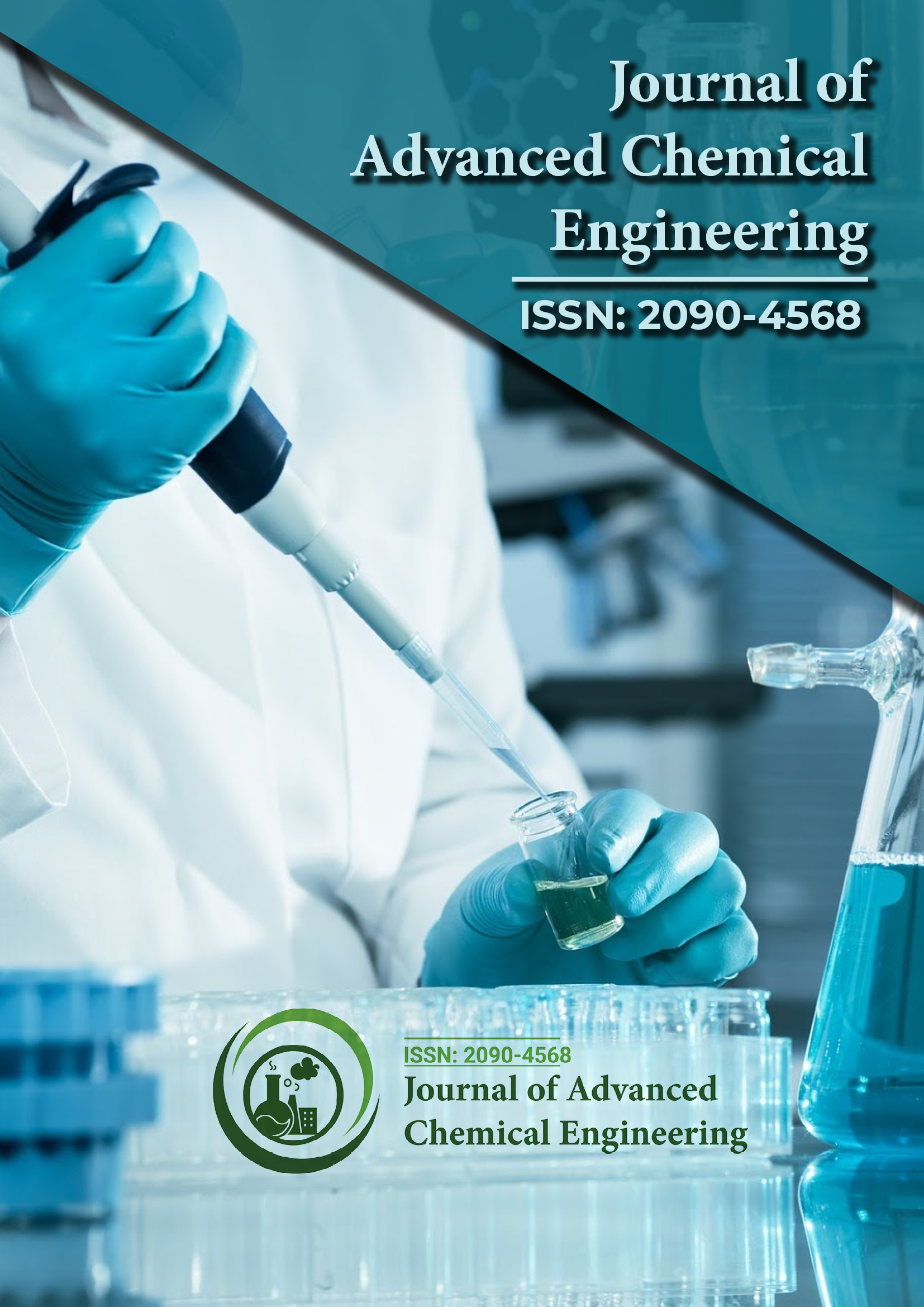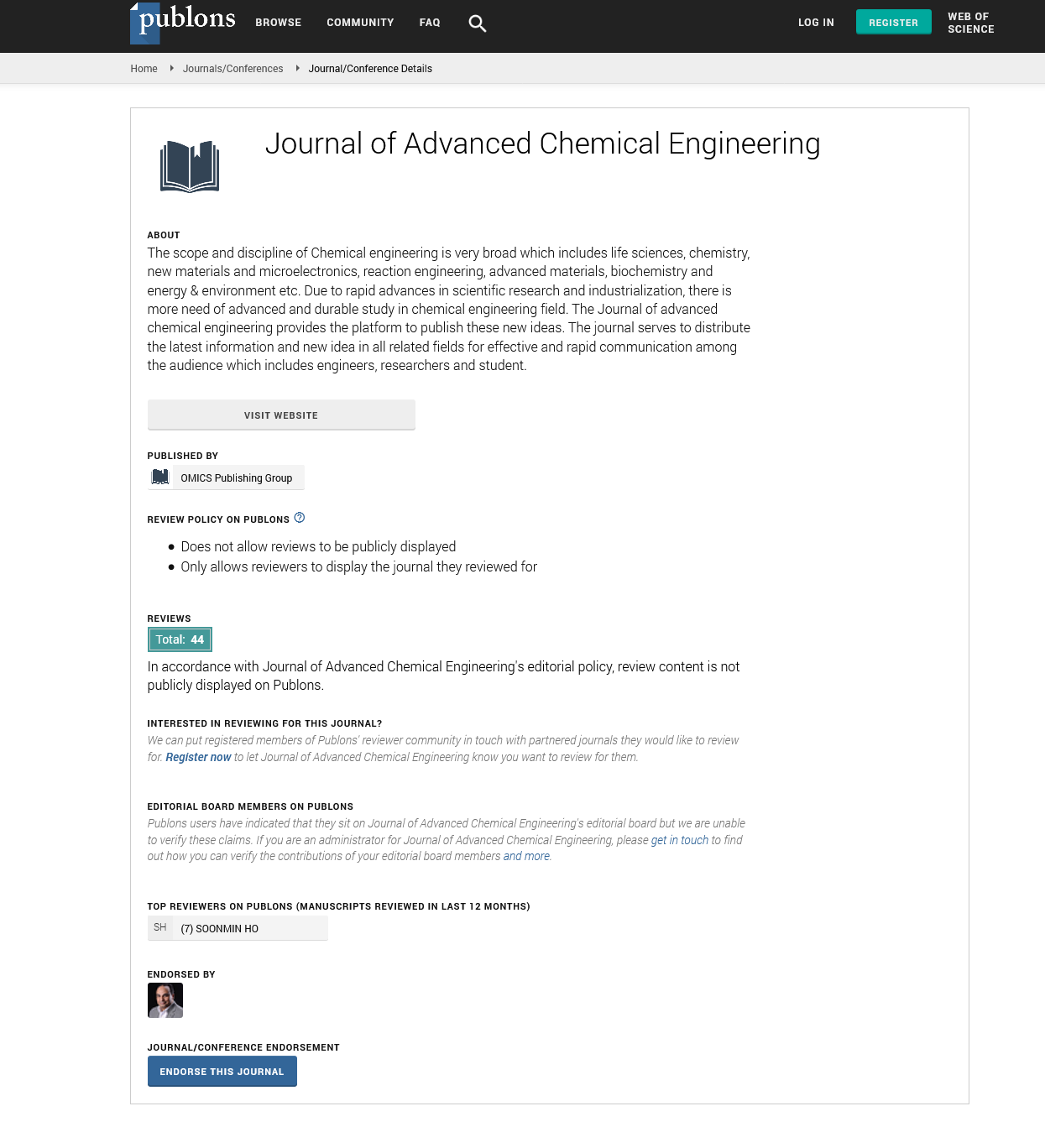Indexed In
- Open J Gate
- Genamics JournalSeek
- Smithers Rapra
- RefSeek
- Directory of Research Journal Indexing (DRJI)
- Hamdard University
- EBSCO A-Z
- OCLC- WorldCat
- Scholarsteer
- Publons
- Geneva Foundation for Medical Education and Research
- Google Scholar
Useful Links
Share This Page
Journal Flyer

Open Access Journals
- Agri and Aquaculture
- Biochemistry
- Bioinformatics & Systems Biology
- Business & Management
- Chemistry
- Clinical Sciences
- Engineering
- Food & Nutrition
- General Science
- Genetics & Molecular Biology
- Immunology & Microbiology
- Medical Sciences
- Neuroscience & Psychology
- Nursing & Health Care
- Pharmaceutical Sciences
Perspective - (2025) Volume 15, Issue 1
Photocatalytic Degradation of Emerging Contaminants in Wastewater Using Titanium Dioxide Nanocomposites
Isabella Rojas*Received: 03-Mar-2025, Manuscript No. ACE-25-29155; Editor assigned: 05-Mar-2025, Pre QC No. ACE-25-29155 (PQ); Reviewed: 19-Mar-2025, QC No. ACE-25-29155; Revised: 26-Mar-2025, Manuscript No. ACE-25-29155 (R); Published: 02-Apr-2025, DOI: 10.35248/2090-4568.25.15.359
Description
The release of emerging contaminants into aquatic environments poses a serious threat to ecosystems and public health. These pollutants, which include pharmaceuticals, personal care products, endocrine-disrupting compounds, and industrial additives, are not effectively removed by conventional wastewater treatment processes. Their persistence and bioaccumulation potential demand the development of advanced treatment technologies. Among the various approaches under investigation, photocatalysis using Titanium Dioxide (TiOâ??) nanocomposites has shown remarkable potential for degrading these hazardous substances under mild conditions with minimal environmental impact.
TiOâ?? is a widely studied photocatalyst due to its chemical stability, non-toxicity, low cost, and strong oxidative potential. When irradiated with ultraviolet light, TiOâ?? generates electronhole pairs that initiate redox reactions at its surface, leading to the formation of Reactive Oxygen Species (ROS) such as hydroxyl radicals and superoxide anions. These ROS are capable of breaking down complex organic molecules into less harmful or completely mineralized products, including carbon dioxide, water, and inorganic salts.
Recent advancements in nanotechnology have greatly enhanced the photocatalytic efficiency of TiOâ??. The use of nanocomposites incorporating TiOâ?? with materials such as graphene oxide, carbon nanotubes, noble metals, and magnetic oxides has led to improved charge separation, extended light absorption, and easier recovery of the catalyst. Graphene-TiOâ?? composites, for example, offer excellent electron conductivity that suppresses the recombination of photo-induced charges, a major limiting factor in photocatalysis. Similarly, doping TiOâ?? with silver, platinum, or palladium nanoparticles enhances visible light responsiveness and catalytic performance through surface plasmon resonance effects.
In laboratory studies, these nanocomposites have demonstrated high degradation rates for contaminants such as diclofenac, carbamazepine, triclosan, and bisphenol A. Batch experiments under simulated solar irradiation have achieved over 90% degradation within a few hours, showing promise for real-world application. Kinetic analysis often follows a pseudo-first-order model, and reaction rates are influenced by factors such as pH, catalyst dosage, initial pollutant concentration, and light intensity. Efforts are also being made to move from batch to continuous flow systems to enable scalability and industrial relevance.
However, the transition from laboratory-scale success to field implementation faces several challenges. The energy requirement for UV light activation is one of the main drawbacks, limiting cost-effectiveness for large-scale deployment. This has spurred research into visible-light-active photocatalysts, where TiOâ?? is modified with dopants such as nitrogen, sulfur, or carbon. These modifications reduce the bandgap energy and shift the absorption spectrum into the visible range, enabling solar-driven photocatalysis.
Another critical factor is the stability and recyclability of the photocatalyst. Nanoparticles tend to aggregate in aqueous environments, which reduces the effective surface area and catalytic activity. Immobilizing TiOâ?? nanocomposites onto inert supports such as glass beads, ceramic membranes, or polymeric films has emerged as a practical solution. These immobilized systems facilitate recovery and reuse of the photocatalyst while maintaining high activity levels.
Environmental and health safety concerns regarding the release of nanoparticles into treated water are being thoroughly investigated. While TiOâ?? is considered safe, the addition of other nanomaterials raises questions about potential toxicity and longterm ecological impacts. Regulatory frameworks are still evolving to address these concerns, and future development must emphasize not only performance but also environmental compatibility.
From a process engineering standpoint, integrating photocatalytic reactors with existing wastewater treatment infrastructure presents logistical and economic considerations. Hybrid systems that couple photocatalysis with biological treatment, membrane filtration, or adsorption techniques are being explored to enhance overall treatment efficiency and reduce operational costs. For instance, pre-treatment with photocatalysis can reduce the toxicity and molecular complexity of pollutants, improving the biodegradability of wastewater and facilitating subsequent biological treatment.
The economic viability of large-scale photocatalytic treatment systems depends on optimizing the reactor design and operating conditions. Flat-plate reactors, slurry systems, and photoreactors with Light-Emitting Diodes (LEDs) offer various trade-offs in terms of efficiency, maintenance, and capital cost. Solar-driven systems are particularly attractive for developing regions with abundant sunlight but limited access to advanced wastewater infrastructure.
Citation: Rojas I (2025). Photocatalytic Degradation of Emerging Contaminants in Wastewater Using Titanium Dioxide Nanocomposites. Adv Chem Eng. 15:359.
Copyright: © 2025 Rojas I. This is an open-access article distributed under the terms of the Creative Commons Attribution License, which permits unrestricted use, distribution, and reproduction in any medium, provided the original author and source are credited.

